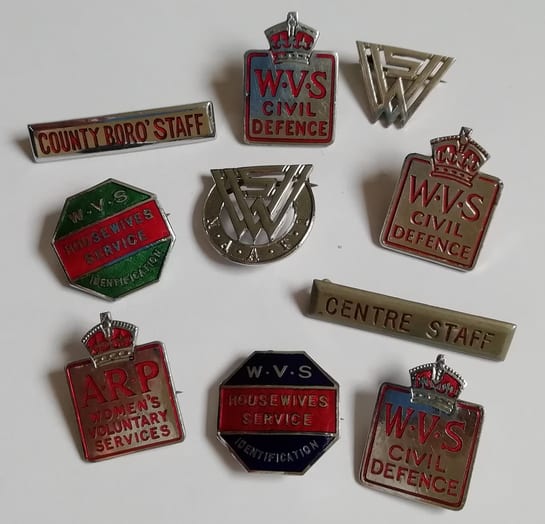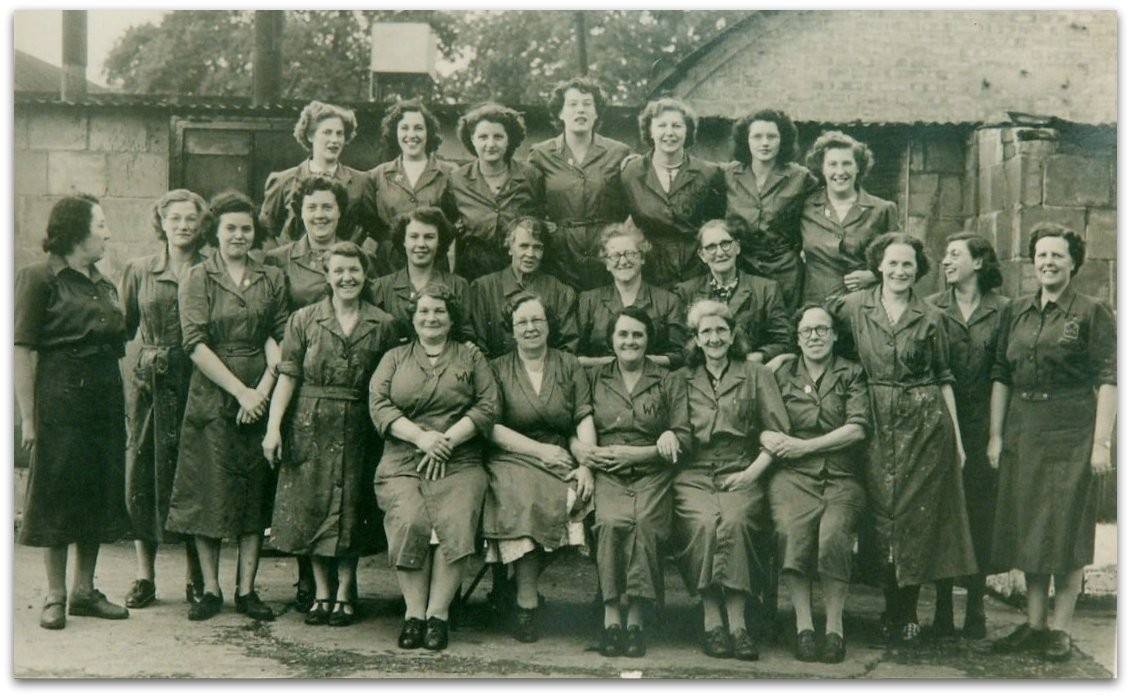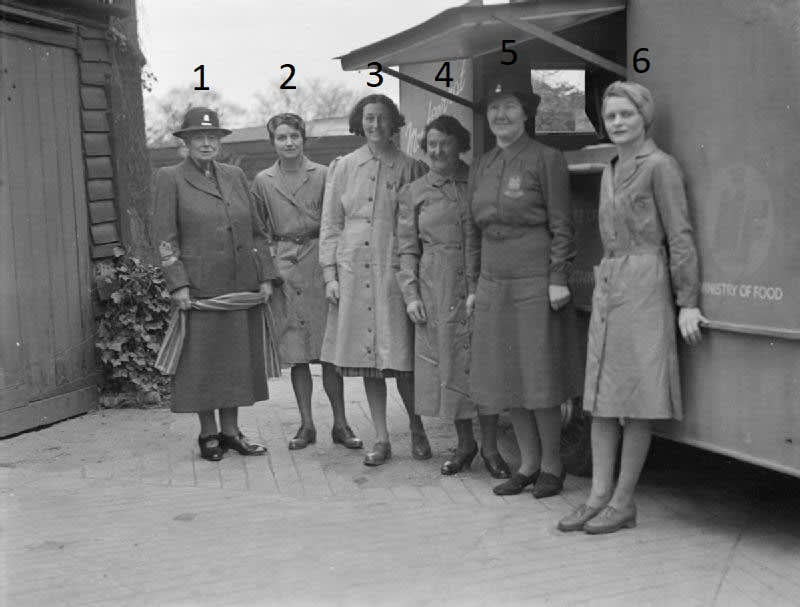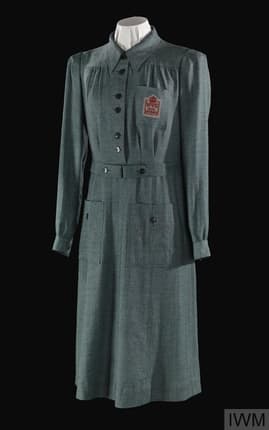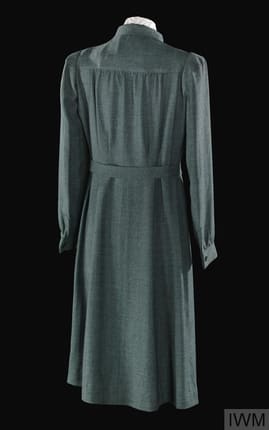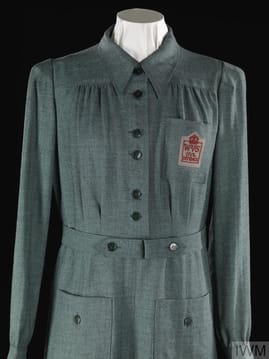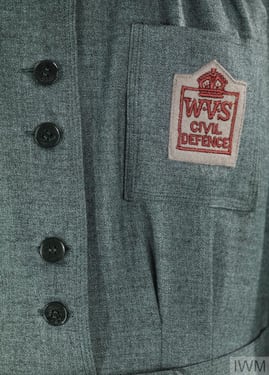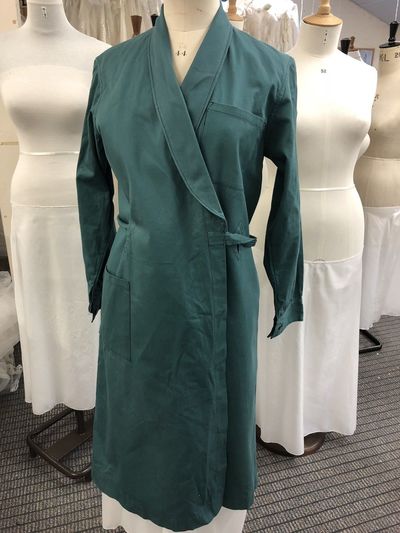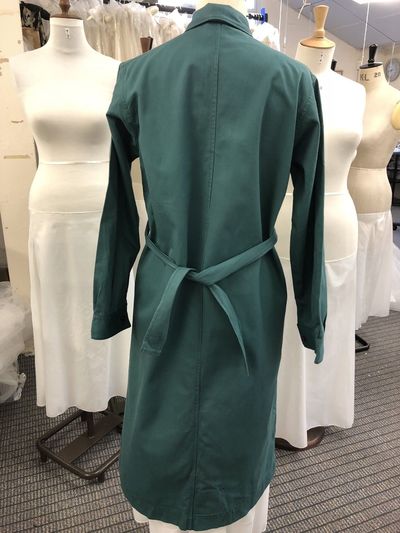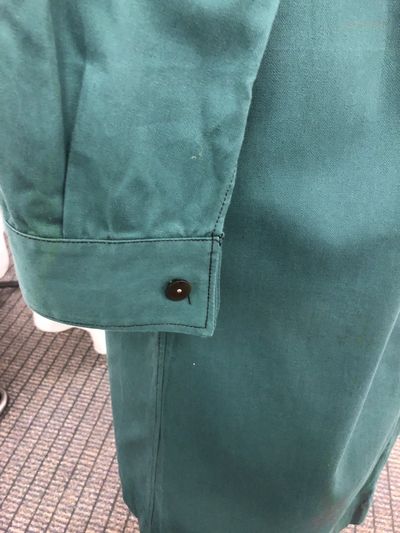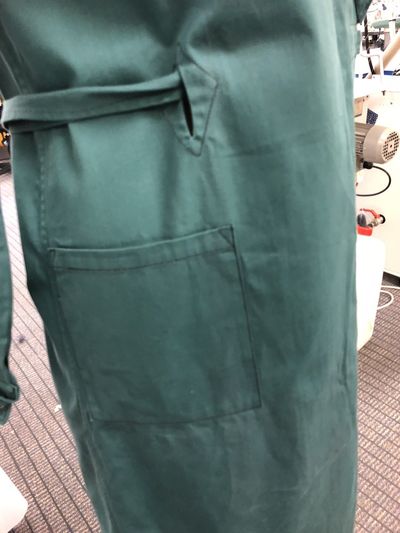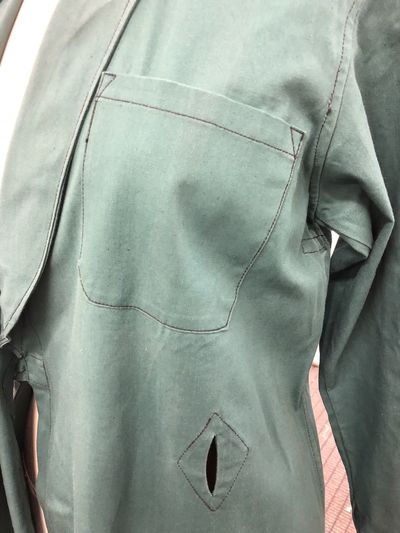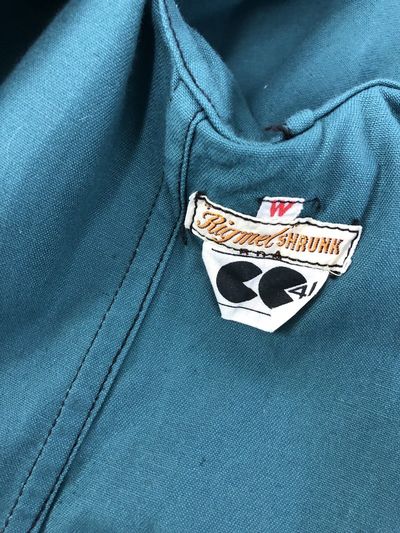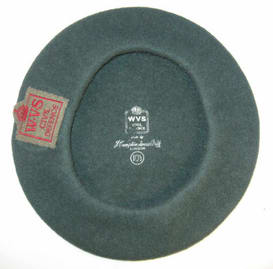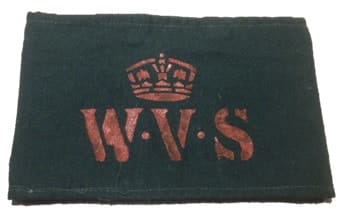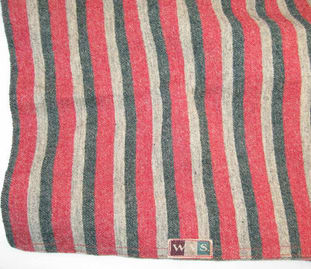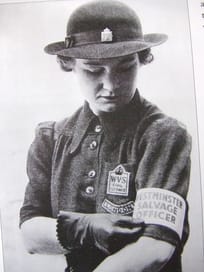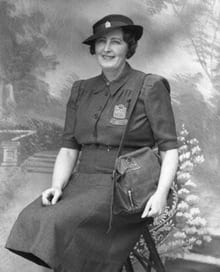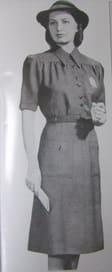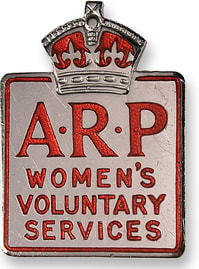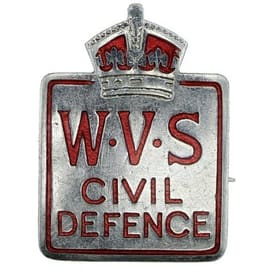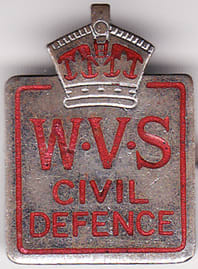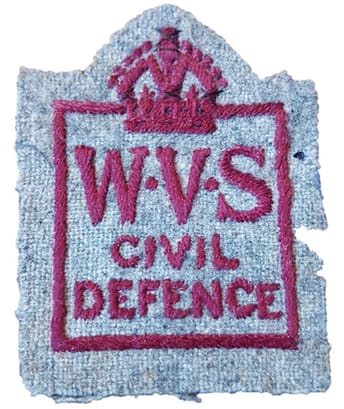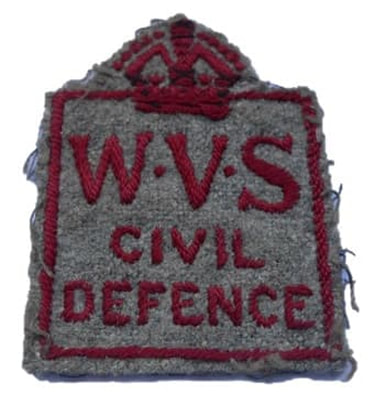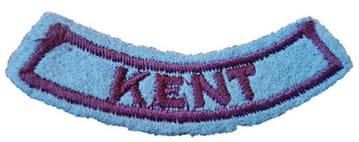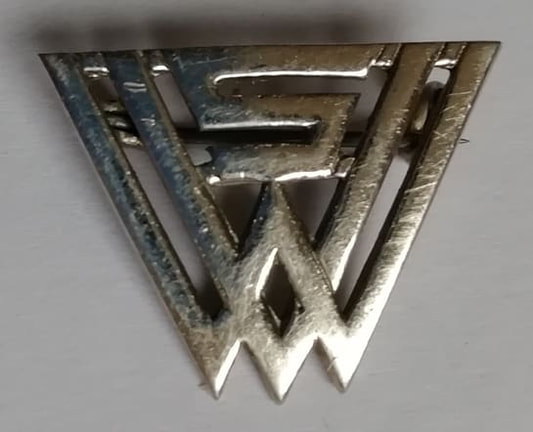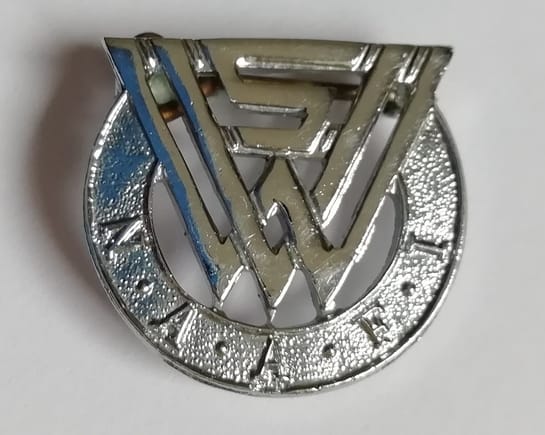Women’s Voluntary Services Uniforms & Insignia during WW2
|
The Women’s Voluntary Services for ARP was officially launched by Lady Reading in June 1938. A short-lived enamel badge (see below) was issued between November 1938 and February 1939 when the WVS changed name to the Women's Voluntary Services for Civil Defence due to its expanded role.
In June of 1939 the first WVS uniform items of overcoat and felt hat became available (designed by Digby Morton); members were responsible for purchasing the uniform at their own cost for use when on civil defence duties. Further uniform items were introduced in late 1939 included a tweed two-piece jacket and skirt, maroon blouse and white wrap-over overalls. Towards the end of 1939 embroidered badges were introduced which also included area markings (similar to those to later appear on CD battledress from 1941). To denote position held within the WVS chromium plated bar brooches were issued in April 1940. For summer wear a new dress was introduced. In the autumn of 1940 jumpers and cardigans were added to the list of available items. A beret was introduced in January 1941 to replace the more expensive felt hat. |
Clothes rationing was introduced in June 1941 and by March 1942 all WVS uniforms were centrally managed by the Ministry of Home Security. Later that year in August, WVS members could purchase material to make their own uniforms. As not every member could afford to buy their uniform, financial support was offered.
A major change to the cost of WVS uniforms came in January 1943. Also introduced were regional strips to denote the region a member belonged to. From March 1943 only the wrap-over overall was available for purchase and armbands were introduced for those without a uniform. War service chevrons were issued from April 1944.
Read a guest blog post from Jon Mills about the Ladies in Green.
A major change to the cost of WVS uniforms came in January 1943. Also introduced were regional strips to denote the region a member belonged to. From March 1943 only the wrap-over overall was available for purchase and armbands were introduced for those without a uniform. War service chevrons were issued from April 1944.
Read a guest blog post from Jon Mills about the Ladies in Green.
WVS uniforms
The below photograph features several of the common WVS uniforms available to volunteers in WW2:
1. Two-piece herringbone tweed WVS suit (from 1939). She holds the official WVS scarf (also 1939). Unusual location of an appointment bar badge worn on the WVS hat (from 1939).
2 and 6: Second pattern economy (with fewer buttons) WVS overall (from summer 1940)
3 and 4: First pattern WVS overall (from late 1939)
5. WVS flannel summer dress (from summer 1940)
(Missing from the photo is the wrapover overall.)
1. Two-piece herringbone tweed WVS suit (from 1939). She holds the official WVS scarf (also 1939). Unusual location of an appointment bar badge worn on the WVS hat (from 1939).
2 and 6: Second pattern economy (with fewer buttons) WVS overall (from summer 1940)
3 and 4: First pattern WVS overall (from late 1939)
5. WVS flannel summer dress (from summer 1940)
(Missing from the photo is the wrapover overall.)
WVS Uniforms, Hats & Accessories
1940 WVS Summer Dress
The summer pattern dress issued in 1940 was a mid-length, long-sleeved dress of grey-green flannel fabric. It had a turn-down collar, fastened at the front with six buttons from neck to waist, had shaping darts to the upper chest and back, a single patch pocket to the left breast, two patch pockets with single-button closures to the front of the skirt, a vertical vent opening to the left side of the waist closed by five press-stud fasteners and button cuffs. The dress came with a detachable waist belt of matching fabric, secured at the front by passing the ends of the belt through a cloth ring and buttoning them back. All buttons are of the plastic four-hole variety and are grey-green in colour to match the dress. Sewn to the breast pocket is a light grey square cloth badge with the text 'W.V.S' above 'CIVIL' above 'DEFENCE' in a square border surmounted by a King's crown in red embroidery. (Images IWM UNI 4740)
When sourcing an original dress it is vital to pay close attention to the design details above. A lot of post-war WVS dresses are sold as wartime but there are a number of differences to be aware of, the key one being that post-war dresses have four sets of two buttons.
WW2 WVS Wrap-over Overall
WW2 WVS beret, armband and scarf
WVS Membership, Rank and Region Insignia/Badges
WVS Membership Badges
The original role of the WVS was to encourage women to join the ARP services as wardens or ambulance drivers or in hospitals. The first pattern badge with ARP on it was issued for only three months from November 1938; it was issued following training and cost 6d to purchase. In February 1939 the WVS changed into the Women's Voluntary Services for Civil Defence and a new badge was issued. A few versions of this badge exist - one with enamelled lettering and a later version with painted lettering (a war-time economy measure).
See this blog post regarding the various makers of the WVC Civil Defence badge.
See this blog post regarding the various makers of the WVC Civil Defence badge.
Comparison of wartime v. post-war WVS badge
WVS Embroidered Cloth Badges
The embroidered cloth WVS Civil Defence badge was introduced in December of 1939. It was worn on the lower right sleeve (five inches from the cuff) of the tweed jacket and overcoat and the left breast of the summer dress. The same badge was also worn on the WVS beret (issued in November 1940). Early issues were on flannel and later on felt.
Note: during the Second World War the WELFARE shoulder title was not issued. It was a post-war title worn by WVS members often attached to Civil Defence Corps duties (such as the Flying Food Squads).
WVS Area Markings / Titles
Positioned one inch below the WVS Civil Defence badge an upward-arched embroidered area marking was worn. Only county and county borough names were used. In April 1942 a "HEADQUARTERS" badge was issued to staff working in them.
WVS Armbands
As not every woman who volunteered with the WVS could afford the cost of a uniform, armbands were issued. In the summer of 1940, a plain green cloth armband with ‘WVS’ in red stencil was made available. From 1943, more robust grey woollen armbands were issued, again with WVS letters now surmounted by a crown embroidered in maroon thread. Additional wording, such as "B.R." (for British Restaurant), "POST LEADER" or "REST CENTRE" were added.
War service chevrons could be added to these armbands.
War service chevrons could be added to these armbands.
WVS War Service Chevrons
In line with other Civil Defence services, WVS members were, from February 1944, allowed to wear war service chevrons. Each maroon-on grey chevron denoted a full 12 months' service. Chevrons could be worn on all uniforms except the overcoat - four inches up from the right cuff on long-sleeve uniforms and two inches on short-sleeve dresses. For WVS members that did not have a uniform the chevrons could also be sewn onto an armband.
WVS Bar Brooches
The WVS followed the Civil Defence Services in being split into 12 regions, each with a Regional Commissioner. Each county had a COUNTY ORGANISER plus COUNTY BORO' STAFF. Within the county were Centres with CENTRE ORGANISER (plus deputies). In the region of 2,000 WVS centres existed during the war.
The wearing of the brooches was as follows: “W.V.S. staff in uniform should wear the brooch on the right lapel of the overcoat or on the right lapel of the jacket over the buttonhole. Staff who do not wear uniform should wear the bar brooch immediately below the W.V.S. badge.”
Chromium-plated bar brooches were introduced in April 1940 to denote a volunteers position within the WVS: "REGIONAL ADMINISTRATOR", "REGIONAL ORGANISER", "COUNTY ORGANISER", "CENTRE ORGANISER" and "HEADQUARTERS STAFF". In Scotland there were additional badges such as "LARGE BURGH ORGANISER".
In March of 1941 the following were added: "AREA ORGANISER" and "REGIONAL STAFF". April 1942 saw "COUNTY STAFF" and "COUNTY BOROUGH ORGANISER" added to the list.
Some brooches that appear but that are not listed by the WVS include the "DEP. CENTRE ORGANISER".
There is a "WVS CLUB LEADER" badge in a similar bar brooch format made by Simpson's but I have been informed this is a post-war badge (though I do not have any documentary evidence at this time to back that up). A red enamel "COUNTY STAFF" badge is also thought to be post war.
The wearing of the brooches was as follows: “W.V.S. staff in uniform should wear the brooch on the right lapel of the overcoat or on the right lapel of the jacket over the buttonhole. Staff who do not wear uniform should wear the bar brooch immediately below the W.V.S. badge.”
Chromium-plated bar brooches were introduced in April 1940 to denote a volunteers position within the WVS: "REGIONAL ADMINISTRATOR", "REGIONAL ORGANISER", "COUNTY ORGANISER", "CENTRE ORGANISER" and "HEADQUARTERS STAFF". In Scotland there were additional badges such as "LARGE BURGH ORGANISER".
In March of 1941 the following were added: "AREA ORGANISER" and "REGIONAL STAFF". April 1942 saw "COUNTY STAFF" and "COUNTY BOROUGH ORGANISER" added to the list.
Some brooches that appear but that are not listed by the WVS include the "DEP. CENTRE ORGANISER".
There is a "WVS CLUB LEADER" badge in a similar bar brooch format made by Simpson's but I have been informed this is a post-war badge (though I do not have any documentary evidence at this time to back that up). A red enamel "COUNTY STAFF" badge is also thought to be post war.
Women's Voluntary Services (WVS) monogram badge & NAAFI badge
Introduced in 1943, the WVS monogram badge could be purchased by any member of the organisation for 4 shillings & 6 pence. Worn usually at the neck on the marron blouse or dress. For those WVS members working with the NAAFI, a special badge was available.
WVS & American Red Cross Great Britain
A number WVS members volunteered to work in American Red Cross (ARC) canteens and service clubs. The blue version of the badge was issued from 1943 for British volunteers working for the ARC for at least 150 hours, the red version was for paid staff who served the ARC in Britain for at least three months. The background to who was issued the GB & WE (Great Britain and Western Europe) isn't currently known but probably paid personnel who were employed for at least three months.
The archivist from the WVS has written a detailed overview of the uniforms of the WVS worn during the second world.
